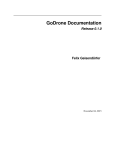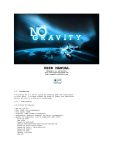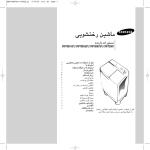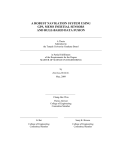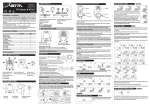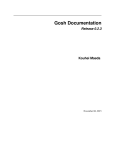Download latest PDF - Read the Docs
Transcript
GoDrone Documentation
Release 0.1.0
Felix Geisendörfer
November 25, 2015
Contents
1
2
User Manual
1.1 Install . . . . . . . . . . . .
1.2 First flight . . . . . . . . .
1.3 Frequently Asked Questions
1.4 Community & Support . . .
1.5 Changelog . . . . . . . . .
.
.
.
.
.
3
3
3
4
6
7
Contributor Manual
2.1 Install from source . . . . . . . . . . . . . . . . . . . . . . . . . . . . . . . . . . . . . . . . . . . .
2.2 Reverse Engineering . . . . . . . . . . . . . . . . . . . . . . . . . . . . . . . . . . . . . . . . . . .
9
9
10
.
.
.
.
.
.
.
.
.
.
.
.
.
.
.
.
.
.
.
.
.
.
.
.
.
.
.
.
.
.
.
.
.
.
.
.
.
.
.
.
.
.
.
.
.
.
.
.
.
.
.
.
.
.
.
.
.
.
.
.
.
.
.
.
.
.
.
.
.
.
.
.
.
.
.
.
.
.
.
.
.
.
.
.
.
.
.
.
.
.
.
.
.
.
.
.
.
.
.
.
.
.
.
.
.
.
.
.
.
.
.
.
.
.
.
.
.
.
.
.
.
.
.
.
.
.
.
.
.
.
.
.
.
.
.
.
.
.
.
.
.
.
.
.
.
.
.
.
.
.
.
.
.
.
.
.
.
.
.
.
.
.
.
.
.
.
.
.
.
.
.
.
.
.
.
.
.
.
.
.
.
.
.
.
.
.
.
.
.
.
i
ii
GoDrone Documentation, Release 0.1.0
GoDrone is a free software 1 alternative firmware for the Parrot AR Drone 2.0. It is developed by Felix Geisendörfer
and Contributors using the Go programming language. There is no affiliation with Parrot and running this firmware
may void your warranty.
The current release is 0.1.0, and is aimed at adventurous software developers. If you’re curious what to expect, check
out this teaser video.
1
GoDrone is licensed under the AGPLv3 license.
Contents
1
GoDrone Documentation, Release 0.1.0
2
Contents
CHAPTER 1
User Manual
1.1 Install
1.1.1 Disclaimer
Please be careful. Ideally you should experiment with this firmware inside a large indoor space. If you go outside,
please try to avoid proximity to streets and people. The worst case scenario is your drone causing a traffic accident,
and you’ll have nobody to blame but yourself.
Installing this software may also void your warranty and cause damage to your drone. But don’t worry, you get back
the original firmware by reconnecting the battery, and it’s very easy to fix your drone if you crash it.
1.1.2 Download
There are currently no downloads available. You need to build from source.
1.1.3 Install
See installing from source.
1.1.4 Uninstall
The go get install process simply adds some files to your $GOPATH directory.
When you run godrone-util, it stops the running copy of the factory firmware, copies the a new executable onto
the drone without touching the factory firmware, and runs it.
If you want the original firmware back, simply disconnect and reconnect the battery. The install is not permanent.
1.2 First flight
You’ll need two windows, running two commands. In one window, start the web server for the user interface:
$ godrone-ui
2014/12/01 21:39:29.057009 Listening on: :8080
In the other window, use godrone-util to cross-compile the drone software and send it to the drone:
3
GoDrone Documentation, Release 0.1.0
$ godrone-util run
Now, you are ready to fly!
1. Make sure that the drone is on a level surface.
2. Open http://127.0.0.1:8080/ in your web browser, you should see the GoDrone web user interface. The user
interface is currently just a set of graphs showing the input (black) and status (red) of the drone.
3. Use the following keys to control the drone:
• ESC: Emergency! Stop all motors. Reload the page to fly again.
• Arrows up/down: Altitude up/down
• Arrows left/right: Yaw
• w/s: Pitch
• a/d: Roll
• p: Pause the graph
• x: Cycle through the graphs
• c: Calibrate (drone must be on a level surface)
You may also be able to use a gamepad controller to fly the drone. You need to be able to configure your controller to
send keys in response to up/down/left/right on the left and right joysticks. You should also remember to configure a
gamepad buttong for “emergency”!
Currently the following configuration is known to work:
• MacOS 10.9.5 (Maverics) with the XBox 360 USB wired controller, the Tattiebogle driver and Enjoyable to
translate gamepad input into keyboard input.
1.2.1 Next steps
First of all, congratulations, you’ve earned the dubious badge of honor for having tried out version 0.1.0 of a drone
software, made by amateur robotics enthusiasts, that you just found on the interwebs! You’re a truly adventurous
person.
Take all the time you need to recover from this experience, but if you feel hungry for more, please start to get involved
with the community. Report your experience, share your problems or demand your money back.
After that, feel free to poke around the source, and maybe even send a patch for that thing that annoyed you the most!
1.3 Frequently Asked Questions
1.3.1 I need help, where can I get support?
The best way to get help is by posting to the godrone mailing list or joining our IRC Channel.
Please keep in mind that this is a volunteer effort, so try to be nice.
4
Chapter 1. User Manual
GoDrone Documentation, Release 0.1.0
1.3.2 I want to help, how can I get involved?
If you’re a designer or a software developer who knows HTML, CSS, JavaScript or Go, the best way to help is by
sending pull requests on GitHub . There are many open issues and ideas, but any proposed changes will be considered.
That being said, it’s always a good idea to post to the godrone mailing to discuss things before getting started.
Additionally help with the documentation and answering questions on the mailing list would be really appreciated.
1.3.3 Where can I report bugs or propose features?
If you’re not sure that what you found is a bug, and you’d like to discuss the problem first, please post to the godrone
mailing list. Otherwise feel free to directly post on our issue tracker.
Features are usually best discussed on the mailing list and added to the tracker once there is consensus.
1.3.4 What happens if the drone goes out of WiFi range?
It could theoretically go up forever (To infinity, and beyond!). So don’t let that happen. Fly indoors until we’ve
implemented a fail-safe of some sort.
1.3.5 Does GoDrone provide any features not provided by the official firmware?
Not a lot at this point, but being able to control the drone with a gamepad using your web browser is nice. It also
seems that the official firmware puts some limits on speed, especially vertically, so you may find that GoDrone will
help you with crashing your drone in more spectacular ways : ).
1.3.6 What are the goals of the project?
The project was started as a personal challenge to write a firmware for the Parrot AR Drone in Go. Now that this is
achieved, there are many possibilities, and it will really depend on whatever users and contributors are most interested
in. Here are a few ideas:
• Improved stabilization and control algorithms (kalman filter, optical flow, etc.)
• Video drivers and support for streaming video to the HTML client
• Compatibility with the various mobile apps and NodeCopter.
• Improved HTML client, e.g. usability, design, graphs, WebGL, support for mobile devices
• More aggresive flight, faster vertical speed, and additional tricks.
• GPS support, including the ability to plan missions in the HTML client on a map
• 3G support, to allow controlling the drone over cellular networks
• Education, e.g. a specialized HTML client to demonstrate quadcopter physics
• Research, GoDrone could make it incredible easy and cheap to reproduce quadcopter research anywhere in the
world.
• Support for uploading JavaScript scripts that run on the drone and allow users to create simple applications.
• Mounting the AR Drone electronics on custom frames, attaching custom sensors, and maybe even using different
motors.
• Encourage vendors such as Parrot to embrace a full open source strategy.
1.3. Frequently Asked Questions
5
GoDrone Documentation, Release 0.1.0
1.3.7 Why is the firmware written in Go?
Originally to see if a firmware like this could be written in a high level garbage collected language.
Go seemed like a good choice because it has great support for cross-compiling, concurrency, systems programming
and is just a very pleasant language to work with.
1.3.8 Isn’t Go unsuitable for real-time applications like this?
This question is one of the reasons this project exists. Go uses a stop-the-world garbage collector that does not provide
any real-time guarantees 1 , so it’s certainly not a perfect fit for a flying robot.
However, for all practical purposes the GC just needs to keep up with the stabilization loop which runs at 200 Hz.
This means that GC pauses below 5ms have no impact on performance. Longer pauses will degrade stabilization
performance, but the tolerance threshold may be up to a second depending on altitude and the situation.
Considering that stabilization cannot be guaranteed due to environmental factors to begin with, it will be interesting to
see if drone vendors will make similar compromises for reducing the costs of software development, or if governments
will provide detailed software architecture regulations for commercial drones.
Given that the AR Drone is a very light weight toy that has an extremely low chance of causing direct harm, the
GoDrone project will continue to use the current approach for now. However, if problems are observed, or the project
becomes more popular than expected, the plan is to rewrite the stabilization loop in C, run it on a separate thread with
strong scheduling guarantees, and use some form of IPC to communicate with it.
1.3.9 Why aren’t you building on existing projects?
This project is about exploring what it would be like to build a drone firmware using a high level language, and
embracing web technologies for providing a portable user interface.
Other projects are certainly more mature at this point, and e.g. Paparazzi already has support for the AR Drone 2.
However, they are significantly more difficult to run and work with, written in C/C++, and use rather archaic UI
technology.
1.3.10 Where can I get the source code?
The source code is available on GitHub: https://github.com/felixge/godrone
1.3.11 What license is GoDrone released under?
GoDrone is licensed under the AGPLv3 license.
This basically means that any derived software products will have to be licensed under the same license, and that their
source code needs to be made available.
The license was chosen to ensure that the GoDrone will always remain free software. Contributors are not asked to
sign a CLA, so there will be no dual licensing model in the future.
1.4 Community & Support
This page lists the best ways for interacting with the GoDrone community.
1
6
What kind of Garbage Collection does Go use?
Chapter 1. User Manual
GoDrone Documentation, Release 0.1.0
1.4.1 godrone mailing list
If you’d like to ask a question, report a bug, or discuss ideas, please post to the godrone mailing list.
1.4.2 #godrone IRC channel
The fastest way to discuss GoDrone related topics is joining the #godrone IRC channel on freenode.net.
1.4.3 Bug / Feature Tracker
Bugs and features are tracked with GitHub issues: https://github.com/felixge/godrone/issues?state=open
1.5 Changelog
1.5.1 Development
The current software is under development and does not have a version number.
1.5.2 0.1.0
2013-12-25: This is the first release. It is aimed at adventurous software developers, and contains the following
features:
• HTML client for controlling the drone via Gamepad. Uses WebSockets, jQuery, and React. Data is simply
rendered into tables. There is no design yet.
• Basic navboard and motorboard drivers.
• Basic binary installer for OSX, Windows and Linux.
• Initial documentation.
• Complementary attitude filter. A kalman filter will likely provide better results in the future.
• Basic PID algorithm for control. This will require more tuning.
• Configuration via simple toml config file. Contributed by gwoo.
• Logging to stdout and log file on the drone.
• Manual altitude control. The ultra sound sensor is already working, but the initial results with it were not good
enough yet. This will require some filtering.
• Automatic flat trim calibration on startup. These values will need to be saved in the future, and the yaw will
have to be reset before takeoff to allow moving the drone around while on the ground.
• ControlTimeout to shut off the motors if the the network connection gets interrupted. Prevents the drone from
flying into outer space.
1.5. Changelog
7
GoDrone Documentation, Release 0.1.0
8
Chapter 1. User Manual
CHAPTER 2
Contributor Manual
2.1 Install from source
2.1.1 OSX & Linux
Before getting started:
• Installed the latest version of Go
• Configure a $GOPATH (e.g. via adding export GOPATH="${HOME}/go" to your ~/.profile)
• Add $GOPATH/bin to your $PATH (e.g. via adding export PATH="${GOPATH}/bin:${PATH}" to
your ~/.profile)
Run the commands below to make sure you’re in good shape:
$ go version
go version go1.2 darwin/amd64
$ go env GOPATH
/Users/felix/code/go
$ echo "${PATH}" | grep -q "$(go env GOPATH)/bin" && echo "good" || echo "bad"
good
Next, you will need to setup Go for cross compiling to Linux/ARM. Luckily this only takes a minute. The fastest way
is this:
$ cd $(go env GOROOT)/src
$ GOOS=linux GOARCH=arm ./make.bash --no-clean
If this doesn’t work for you for some reason, you may try to follow Dave Cheney’s guide for cross compiling Go
instead.
Download, compile, and install GoDrone into $GOPATH/bin:
$ go get github.com/felixge/godrone/cmd/godrone-util
$ go get github.com/felixge/godrone/cmd/godrone-ui
2.1.2 Windows
Building on windows is probably also doable, but has not been attempted yet. Please contribute to the docs if you get
it working.
9
GoDrone Documentation, Release 0.1.0
2.2 Reverse Engineering
To be written. Guide to the techniques used for reverse engineering the Parrot AR Drone 2.0.
10
Chapter 2. Contributor Manual














